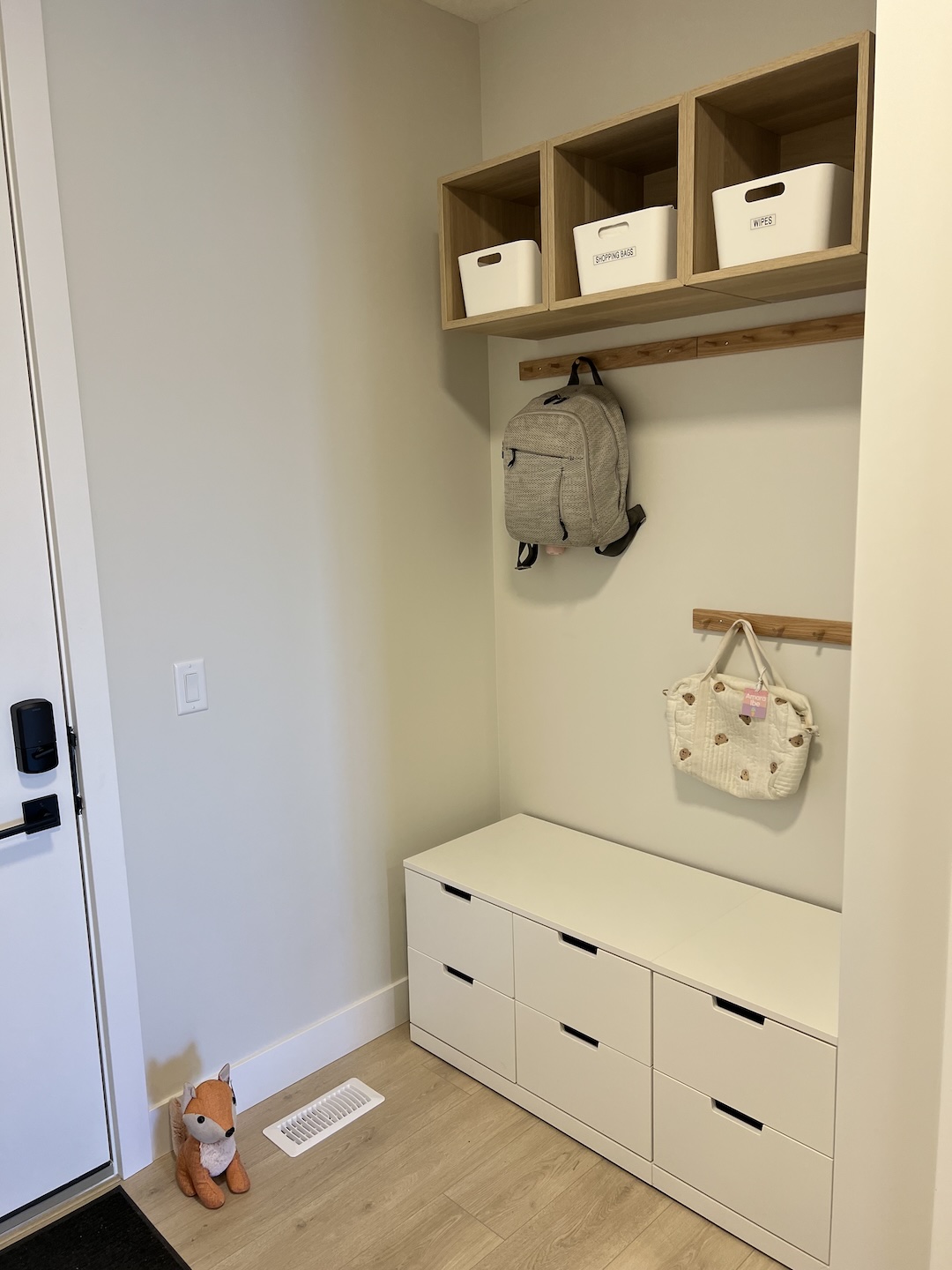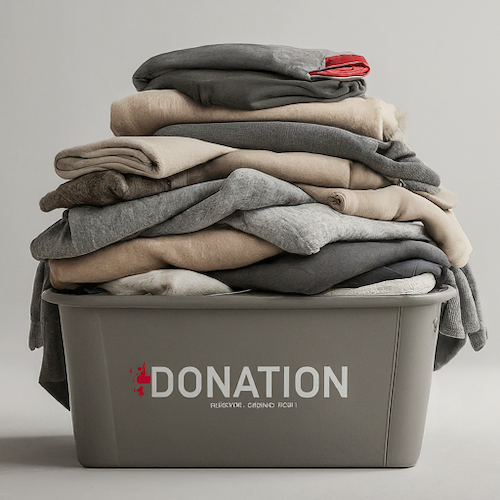Clutter doesn’t just fill shelves and drawers. It fills your mind, too. Even if you think you’ve tuned it out, your brain hasn’t. That pile on the counter, the messy drawer, the baskets of who-knows-what in the hallway—all of it is quietly demanding your attention.
Researchers at UCLA spent years studying families in their homes, and what they found was striking: the more belongings in a home, the higher the stress levels, especially for moms. Cortisol (that’s your stress hormone) spiked in direct response to visible clutter.
Mess is making you feel wired, tired, and constantly behind.
But don’t worry, in this guide, we’ll give you doable strategies to help your home feel more calm, clear, and livable again.
1. The Psychology of Clutter: Why It’s More Than Just Stuff
Studies show that clutter competes for your attention. It overloads your visual cortex and makes it harder to concentrate. In short: your brain sees every out-of-place object as something unresolved. It’s like your brain can’t fully relax when it’s surrounded by unfinished business.
Children, too, have a harder time focusing or calming down in chaotic environments.
2. Where to Start When Everything Feels Like Too Much
Most people make the mistake of starting with the most visible clutter, like the kitchen counter or entryway drop zone, but these spots are often the trickiest because everything there needs to stay. That’s not the place to begin. You want quick wins and easy yes-or-no decisions to build momentum.
Here’s where I recommend starting instead:
- The kitchen utensil drawer – This is a small, defined space. You already know what belongs here and what doesn’t. Duplicates, broken spatulars and single use gadgets you never reach for are easy to let go.
- The junk drawer – Everyone has one. You don’t need ten pens, random screws, and the “what is this even for?” items. Give yourself permission to toss without guilt.
- Your top office drawer – That drawer full of sticky notes, pens, paper clips, batteries, cords… Pick a category, toss the junk, and put the keepers into dividers.
Once you see a tidy drawer, your brain gets a little hit of motivation. It’s a visual reminder that yes, you can do this.

3. Decluttering Mindset Tricks That Actually Work
Decluttering is a mindset game, that’s why it helps to have know a few tricks to outsmart your brain excuses and get yourself moving.
Here are three powerful mindset shifts to try:
- The Spontaneous Combustion Rule (from The Minimalists)
Ask yourself, “If this item spontaneously combusted right now, would I replace it?”
If the answer is no—or worse, if you’d be kind of relieved—then why are you holding onto it? You’ve just been granted permission to let it go.
- The KonMari Question: “Does it spark joy?”
You’ve probably heard this one before, but when used correctly, it really works. The trick? Don’t ask it with your head—ask with your heart.
Hold the item. Do you feel happy? Nostalgic? Light? Great—keep it.
If your first reaction is guilt or “meh,” that’s your answer too. Thank it, and move on.
This approach is especially great for sentimental items, clothing, and home decor.
- The 15-Minute Rule
Feeling stuck? Don’t wait for motivation. Set a timer for just 15 minutes and tell yourself, “I’m just going to do a little bit.”
Odds are, once you start, you’ll keep going. But even if you don’t—you still made progress. One drawer, one basket, one win.
These mindset shifts aren’t just about tricks—they’re about building a new relationship with your stuff. One that feels lighter, more intentional, and totally manageable.
4. How to Let Go of Sentimental or “Just in Case” Items
This is where most people get stuck, not with the junk drawer or the mismatched Tupperware lids, but with the “what if I need this someday?” and the “but my kid made it in preschool” items.
Let’s talk strategy.
- The 20/20 Rule from The Minimalists: If it costs less than $20 and can be replaced in under 20 minutes, it’s safe to let go. Even if you have to replace one or two things down the road, it’s worth the clarity and space you’ll gain now—think of it as decluttering insurance.
- Sentimental clutter rule: If everything is special, nothing is. Limit yourself to one sentimental box. When it’s full, reassess—are these items really meaningful, or are you just avoiding a hard decision?
- Turn art into albums: I cannot tell you how many times I come accross “special box with kids art” that is totally ruined. Some pieces fallen off, some drawing are squished and bent or stuck together. Doesn’t seem like it’s that special after all. Companies like Artkive let you send in your kids’ artwork and turn it into a printed book—saving space and actually preserving artwork.
Remember: Memories don’t live in things. They live in you.
5. How to Maintain a Clutter-Free Home (Without Losing Your Mind)
How do you stay on top of the mess without feeling like you’re constantly tidying? Here are a few low-effort, high-impact maintenance habits that make all the difference:
- The 5-Minute Reset: Every evening, do a quick sweep. Toys back in bins, shoes by the door, mail sorted. It takes less time than scrolling Instagram, and your future self will thank you.
- The Monthly Mini Declutter : Set a reminder on your phone: once a month, pick a small area to recheck. A drawer, a shelf, a bin. That’s it.
- 1-in-1-out Rule: Every time you bring something new into your home, one item must go. Bought a new pair of jeans? Donate an old pair that doesn’t fit right. Got a new mug? Remove the chipped one you never reach for.
- Add donation baskets: Make it ridiculously easy to declutter by keeping a donation basket in your master closet and in each kid’s closet. Tried on something and it didn’t fit right? Toss it in the donate bin. When it’s full, bag it and drop it off. Easy.
- One Trip, One Fix: Every time you go up or down the stairs, grab something that’s out of place and return it. Pair of socks on the stairs? A toy halfway to the basement? That coffee mug that’s been sitting on the nightstand for a suspiciously long time? Take it with you.
6. Decluttering With Kids or a Not-So-Enthusiastic Partner
You’re pumped and ready to create a calm, functional home. And then you hit a wall, your child wants to hold on to a broken Happy Meal toy like it’s a family heirloom, or your spouse insists on keeping all the manuals and cords to old electronics that don’t even work anymore.
Here’s how to make progress without getting into a fight:
For Kids: Make It a Game. Kids respond so well to fun. Instead of saying, “Go clean your room,” try:
- The 5-Minute Challenge: Set a timer and say, “Find 5 things you don’t use or love anymore.” Participate as well, find 5 things you can declutter as well.
- Declutter Bingo: Create a simple bingo sheet with categories like “Something broken,” “A toy I’ve outgrown,” “Something I don’t remember owning.” Reward with stickers or extra bedtime stories.
- Donate with Purpose: Talk about where their toys will go: another child, a community centre, or a local donation drive. When they understand it’s helping someone, they’re more likely to let go.
For Partners: Lead by Example. Nagging doesn’t work (we wish it did). Instead:
- Start in your zones: your closet, your desk, the kitchen drawer.
- Keep your progress visible. A freshly organized space is magnetic, it often inspires others to get onboard.
- If they’re hesitant, use a “Maybe Box.” Items go in for 30 days. If no one touches them in that time? It’s probably safe to say goodbye.
- Shared spaces can have shared rules.
- Personal spaces should be respected, even if you close the door and pretend that overflowing desk doesn’t exist.

7. Sustainable Decluttering: Do Good While Letting Go
Let’s face it: letting go of stuff is already emotional. Add in worries about waste, and suddenly you’re holding onto things because “it would feel bad to throw this away.” That’s why sustainable decluttering matters, it helps you release things responsibly while doing good for your home, your community, and the planet.
Donate: If something is clean, functional, and in good shape, chances are someone else can use it. You can donate it to thrift stores. Some people insist to finding a friend to give it to. That’s fine but if you cannot find anyone who wants it, a good rule of thumb: if you’d give it to a friend, you can donate it.
For large items, or things thrift stores don’t accept (like baby gadgets) post it for free on Facebook Marketplace. Someone will pick it up by end of the day.
Recycle the right way: Recycling gets tricky, especially for items made of mixed materials, like spiral notebooks. But it’s worth learning your local rules to keep clutter out of landfills. Search “[your city] + recycling guide” to get local info.
Some quick guidelines:
- Electronics & Batteries: Take old phones, cords, or laptops to e-waste collection points or stores like Staples and Best Buy.
- Mixed materials: If an item is made of two different materials separate them before recycling. If that’s not possible, it belongs in the trash.
- Going through cards or kids artwork? If it had glitter or glue, put it in a garbage bin. Same goes for broken plastic or wooden toys.
8. Apps & Checklists to Make Decluttering Easier
If you’re someone who loves using technology to streamline life there are some genuinely helpful apps that can turn your decluttering goals into satisfying progress.
Decluttering Apps That Actually Help
- Sortly – Create a visual inventory of what’s in each bin, drawer, or closet. No more digging around wondering where you stashed something.
- Decluttr – Sell your old tech, DVDs, and electronics. It’s easy, and it keeps things out of landfills.
- iRecycle – This app tells you where to recycle pretty much anything.
- Buy Nothing / Freecycle – For giving things away in your city with minimal effort.
A Printable Decluttering Checklist
If you prefer something you can hold in your hands and cross off with a big, satisfying checkmark? Use a room-by-room decluttering checklist to get you started and build a real momentum.
[Click here to download your free checklist.]
9. Smart Decluttering Tips for Small Spaces
With a few strategic changes, even the tiniest of homes can feel calm, clear, and functional.
- Accept the Limits of Your Space: In small spaces, every inch counts—and there’s no room for “just in case” clutter. The hard truth? You can’t keep everything. Get comfortable with the idea that your home has boundaries, and honoring them is what brings peace.
- Skip Bulk Shopping: In smaller homes, those jumbo packs of paper towels or a 40-pound bag of rice just end up eating valuable real estate. A few dollars saved isn’t worth the daily frustration of a cramped cabinets.
- Prioritize Multi-Use & Compact Items: Go for items that do multiple jobs, like a bench that hides storage inside. Think versatile, stackable, and collapsible whenever possible.
- Declutter Vertically: Make use of vertical space with wall-mounted hooks, over-the-door organizers, tall shelving, and magnetic strips for knives.
- Rotate: Consider doing a seasonal switch for your closet. Place off season clothes in the bins under your bed. If you’ve got kids, do a toy rotation system. Keep only a few toys out at a time and store the rest. It cuts down on mess and keeps things fresh and exciting.
You don’t have to do it all. You just have to start. Decluttering is about making space for calm, for clarity, and for the life you actually want to live. Try one strategy this week and watch how your space transforms.
Read next: Want a Calmer Life? This One-Week Minimalist Routine Actually Works







